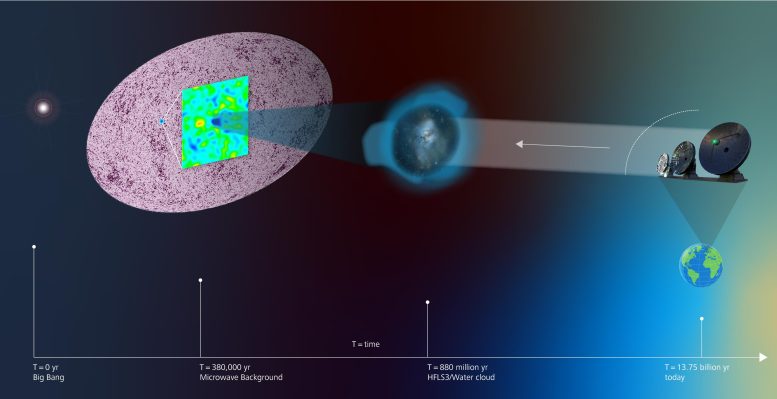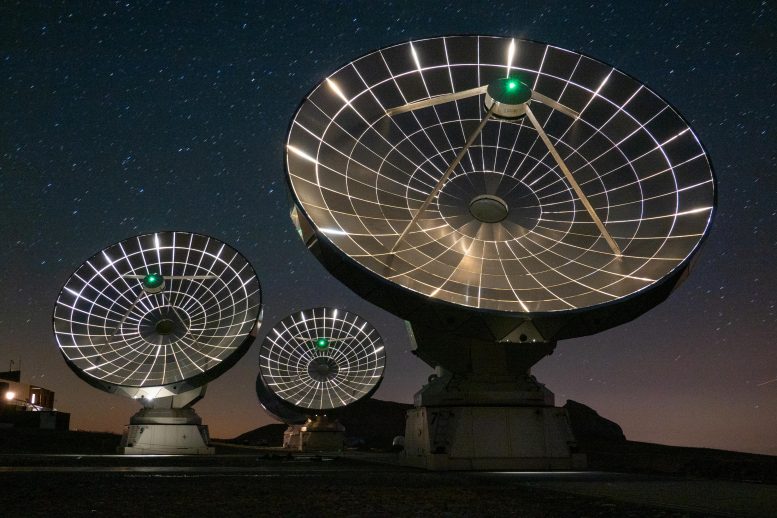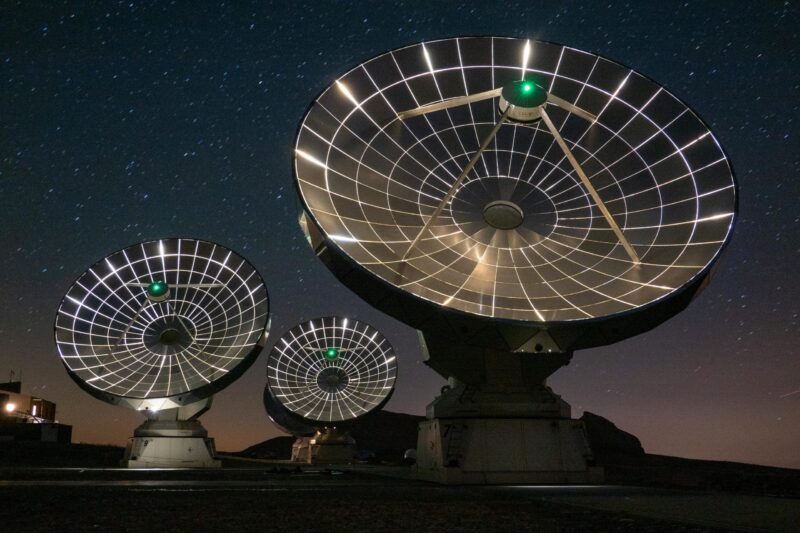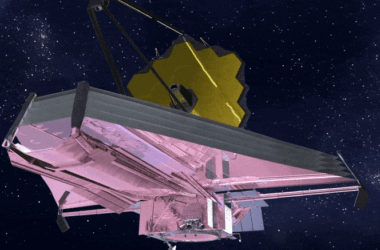
Le fond diffus cosmologique (à gauche) a été libéré 380 000 ans après le Big Bang, et il sert de fond à toutes les galaxies de l’Univers. La galaxie en étoile HFLS3 est encastrée dans un grand nuage de vapeur d’eau froide (au milieu, indiqué en bleu), et est observée 880 millions d’années après le Big Bang. En raison de sa basse température, l’eau projette une ombre sombre sur le fond micro-onde (panneau de zoom avant à gauche), correspondant à un contraste environ 10 000 fois plus fort que ses fluctuations intrinsèques de seulement 0,001 % (taches claires/sombres). Crédit : ESA et la collaboration Planck ; panneau de zoom avant : Dominik Riechers, Université de Cologne ; composition de l’image : Martina Markus, Université de Cologne
Un groupe international d’astrophysiciens a découvert une nouvelle méthode pour estimer la température du fond diffus cosmologique de l’Univers jeune, seulement 880 millions d’années après la Big Bang. It is the first time that the temperature of the cosmic microwave background radiation – a relic of the energy released by the Big Bang – has been measured at such an early epoch of the Universe.
The prevailing cosmological model assumes that the Universe has cooled off since the Big Bang – and still continues to do so. The model also describes how the cooling process should proceed, but so far it has only been directly confirmed for relatively recent cosmic times. The discovery not only sets a very early milestone in the development of the cosmic background temperature, but could also have implications for the enigmatic dark energy. The article ‘Microwave background temperature at a redshift of 6.34 from H2O absorption’ was published in Nature on February 2, 2022.
The scientists used the NOEMA (Northern Extended Millimeter Array) observatory in the French Alps, the most powerful radio telescope in the Northern Hemisphere, to observe HFLS3, a massive starburst galaxy at a distance corresponding to an age of only 880 million years after the Big Bang. They discovered a screen of cold water gas that casts a shadow on the cosmic microwave background radiation. The shadow appears because the colder water absorbs the warmer microwave radiation on its path towards Earth, and its darkness reveals the temperature difference. As the temperature of the water can be determined from other observed properties of the starburst, the difference indicates the temperature of the Big Bang’s relic radiation, which at that time was about seven times higher than in the Universe today.

Antennas of the NOEMA observatory (MPG/Germany, CNRS/France, IGN/Spain). Using their unique resolving power, astronomers probed the early Universe and found a new method for measuring the cosmic microwave background’s temperature. NOEMA is the most powerful radio telescope in the Northern Hemisphere. The observatory operates at over 2500 meters above sea level on one of the most extended European high altitude sites, the Plateau de Bure in the French Alps. The telescope is operated by the Institut de Radioastronomie Millimétrique (IRAM) and is financed by the Max-Planck Society (Germany), the Centre National de Recherche Scientifique (France) and the Instituto Geografico Nacional (Spain). Credit: IRAM, A.Ramboud
“Besides proof of cooling, this discovery also shows us that the Universe in its infancy had some quite specific physical characteristics that no longer exist today,” said lead author Professor Dr. Dominik Riechers from the University of Cologne’s Institute of Astrophysics. “Quite early, about 1.5 billion years after the Big Bang, the cosmic microwave background was already too cold for this effect to be observable. We have therefore a unique observing window that opens up to a very young Universe only,” he continued. In other words, if a galaxy with otherwise identical properties as HFLS3 were to exist today, the water shadow would not be observable because the required contrast in temperatures would no longer exist.
“This important milestone not only confirms the expected cooling trend for a much earlier epoch than has previously been possible to measure, but could also have direct implications for the nature of the elusive dark energy,” said co-author Dr. Axel Weiss from the Max Planck Institute for Radio Astronomy (MPIfR) in Bonn. Dark energy is thought to be responsible for the accelerated expansion of the Universe over the past few billion years, but its properties remain poorly understood because it cannot be directly observed with the currently available facilities and instruments. However, its properties influence the evolution of cosmic expansion, and hence the cooling rate of the Universe over cosmic time.
Based on this experiment, the properties of dark energy remain – for now – consistent with those of Einstein’s “cosmological constant.” “That is to say, an expanding Universe in which the density of dark energy does not change,” explained Weiss.
Having discovered one such cold water cloud in a starburst galaxy in the early Universe, the team is now setting out to find many more across the sky. Their aim is to map out the cooling of the Big Bang echo within the first 1.5 billion years of cosmic history. “This new technique provides important new insights into the evolution of the Universe, which are very difficult to constrain otherwise at such early epochs,” Riechers said.
“Our team is already following this up with NOEMA by studying the surroundings of other galaxies,” said co-author and NOEMA project scientist Dr. Roberto Neri. “With the expected improvements in precision from studies of larger samples of water clouds, it remains to be seen if our current, basic understanding of the expansion of the Universe holds.”
Reference: “Microwave background temperature at a redshift of 6.34 from H2O absorption” by Dominik A. Riechers, Axel Weiss, Fabian Walter, Christopher L. Carilli, Pierre Cox, Roberto Decarli and Roberto Neri, 2 February 2022, Nature.
DOI: 10.1038/s41586-021-04294-5
Dominik Riechers (University of Cologne) conducted the study together with his colleagues Axel Weiss (Max Planck Institute for Radio Astronomy, MPIfR), Fabian Walter (Max Planck Institute for Astronomy, MPIA), Christopher L. Carilli (National Radio Astronomy Observatory, NRAO), Pierre Cox (Institut d’Astrophysique de Paris, IAP, and Sorbonne Université), Roberto Decarli (INAF – Osservatorio di Astrofisica e Scienza dello Spazio), and Roberto Neri (Institut de RadioAstronomie Millimétrique, IRAM).
The study was funded by the US National Science Foundation, the Alexander von Humboldt Foundation, the Max Planck Society, Institut National des Sciences de l’Univers/Centre National de la Recherche Scientifique, and Instituto Geográfico Nacional.



